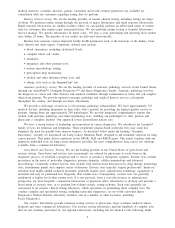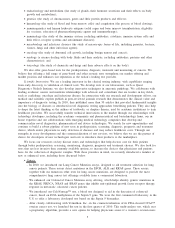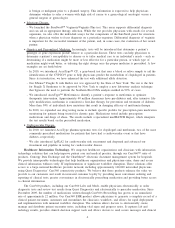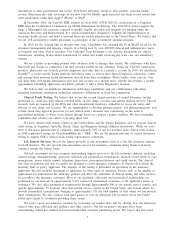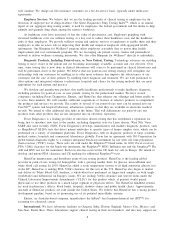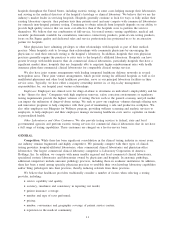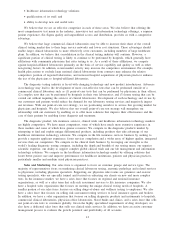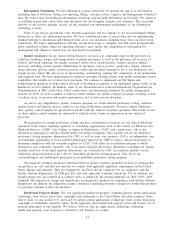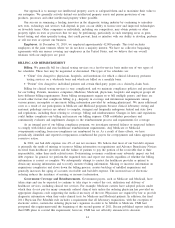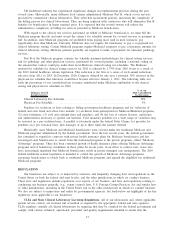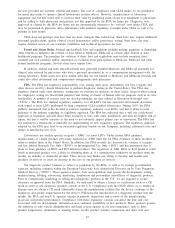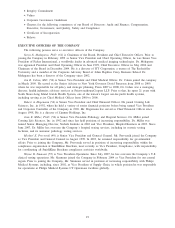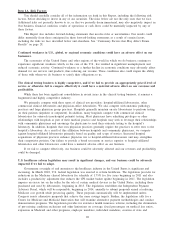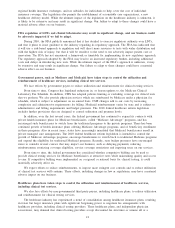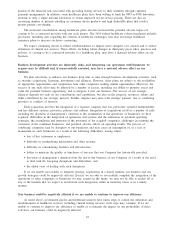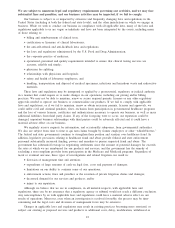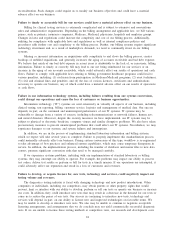Quest Diagnostics 2010 Annual Report Download - page 17
Download and view the complete annual report
Please find page 17 of the 2010 Quest Diagnostics annual report below. You can navigate through the pages in the report by either clicking on the pages listed below, or by using the keyword search tool below to find specific information within the annual report.Our approach is to manage our intellectual property assets to safeguard them and to maximize their value to
our enterprise. We generally actively defend our intellectual property assets and pursue protection of our
products, processes and other intellectual property where possible.
Our success in remaining a leading innovator in the diagnostic testing industry by continuing to introduce
new tests, technology and services will depend, in part, on our ability to license new and improved technologies
on favorable terms. Other companies or individuals, including our competitors, may obtain patents or other
property rights on tests or processes that we may be performing, particularly in such emerging areas as gene-
based testing and other specialty testing, that could prevent, limit or interfere with our ability to develop, perform
or sell our tests or operate our business.
Employees. At December 31, 2010, we employed approximately 42,000 people. This total excludes
employees of the joint ventures where we do not have a majority interest. We have no collective bargaining
agreements with any unions covering any employees in the United States, and we believe that our overall
relations with our employees are good.
BILLING AND REIMBURSEMENT
Billing. We generally bill for clinical testing services on a fee-for-service basis under one of two types of
fee schedules. These fees may be negotiated or discounted. The types of fee schedules are:
•“Client” fees charged to physicians, hospitals, and institutions for which a clinical laboratory performs
testing services on a wholesale basis and which are billed on a monthly basis.
•“Patient” fees charged to individual patients and certain third-party payers on a claim-by-claim basis.
Billing for clinical testing services is very complicated, and we maintain compliance policies and procedures
for our billing. Patients, insurance companies, Medicare, Medicaid, physicians, hospitals and employer groups all
have different billing requirements. Some billing arrangements require us to bill multiple payers, and there are
several other factors that complicate billing (e.g., disparity in coverage and information requirements among
various payers; incomplete or inaccurate billing information provided by ordering physicians). We incur additional
costs as a result of our participation in Medicare and Medicaid programs because clinical laboratory testing and
anatomic pathology services are subject to complex, stringent and frequently ambiguous federal and state laws
and regulations, including those relating to coverage, billing and reimbursement. Changes in laws and regulations
could further complicate our billing and increase our billing expense. CMS establishes procedures and
continuously evaluates and implements changes to the reimbursement process and requirements for coverage.
As an integral part of our billing compliance program, we investigate reported failures or suspected failures
to comply with federal and state healthcare reimbursement requirements. Any Medicare or Medicaid
overpayments resulting from non-compliance are reimbursed by us. As a result of these efforts, we have
periodically identified and reported overpayments, reimbursed the payers for overpayments and taken appropriate
corrective action.
In 2010, our bad debt expense was 4% of our net revenues. We believe that most of our bad debt expense
is primarily the result of missing or incorrect billing information on requisitions and Advance Beneficiary Notices
received from healthcare providers and the failure of patients to pay the portion of the receivable that is their
responsibility, rather than credit related issues. Deteriorating economic conditions may adversely impact our bad
debt expense. In general, we perform the requested tests and report test results regardless of whether the billing
information is correct or complete. We subsequently attempt to contact the healthcare provider or patient to
obtain any missing information and to rectify incorrect billing information. Missing or incorrect information on
requisitions complicates and slows down the billing process, creates backlogs of unbilled requisitions and
generally increases the aging of accounts receivable and bad debt expense. The increased use of electronic
ordering reduces the incidence of missing or incorrect information.
Government Coverage and Reimbursements. Government payers, such as Medicare and Medicaid, have
taken steps and can be expected to continue to take steps to control the cost, utilization and delivery of
healthcare services, including clinical test services. For example, Medicare carriers have adopted policies under
which they do not pay for many commonly ordered clinical tests unless the ordering physician has provided an
appropriate diagnosis code supporting the medical necessity of the test. Physicians are required by law to provide
diagnostic information when they order clinical tests for Medicare and Medicaid patients. In addition, the final
2011 Physician Fee Schedule rule includes a requirement that all laboratory requisitions, with the exception of
electronic orders, contain the ordering physician’s signature in order to be billable to Medicare. CMS had
postponed this requirement until the beginning of the second quarter of 2011. Recent published reports indicate
that CMS plans to rescind this requirement; however, CMS has not officially announced its decision.
14


